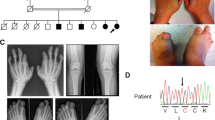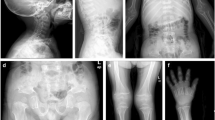Abstract
We present a second family with survival to adulthood and dominant transmission of the Torrance-Luton type of platyspondylic chondrodysplasia, and demonstrate the radiographs at different ages together with radiographs and further data of the first family which was published in the Journal of Pediatrics (J Pediatr 136:411–413). Two families are described with survival to adulthood and dominant transmission of the Torrance-Luton type of platyspondylic chondrodysplasia. Although lethality is increased in patients with this disorder, mild expressions of the genetic defect are compatible with survival into adulthood. The heterogeneous group of platyspondylic lethal skeletal dysplasias (PLSD) originally included thanatophoric dysplasias (TD1/2: MIM 187600, 187100) as the most common forms of this condition, as well as TD variants San Diego type (PLSD-SD: MIM 270230) and Torrance-Luton type (PLSD-TL: MIM 151210). Fibroblast growth factor receptor 3 (FGFR3) gene mutations have been detected in TD1/2 and PLSD-SD. Molecular studies in one of our two families with the Torrance-Luton type did not disclose mutations in the FGFR3 coding region, suggesting that this type of platyspondylic chondrodysplasia is not a thanatophoric dysplasia variant. In contrast to TD1/2 and PLD-SD, the Torrance-Luton type platyspondylic dysplasia is compatible with survival to adulthood.





Similar content being viewed by others
References
Horton WA, Rimoin DL, Hollister DW, et al (1979) Further heterogeneity within lethal neonatal short-limbed dwarfism: the platyspondylic types. J Pediatr 94:736–742
Winter RM, Thompson EM (1982) Lethal, neonatal, short-limbed platyspondylic dwarfism. A further variant? Hum Genet 61:269–272
Nishimura G, Iwasawa T, Fukuzawa R, et al (1998) Variability of platyspondylic lethal chondrodysplasia: another case report. Clin Dysmorphol 7:195–200
Brodie SG, Kitoh H, Lachman RS, et al (1999) Platyspondylic lethal skeletal dysplasia, San Diego type, is caused by FGFR3 mutations. Am J Med Genet 84:476–480
Omran H, Uhl M, Brandis M, et al (2000) Survival and dominant transmission of "lethal" platyspondylic dwarfism of the "West coast" types. J Pediatr 136:411–413
Wüchner C, Hilbert K, Zabel B, et al (1997): Human fibroblast growth factor receptor 3 gene (FGFR3): genomic sequence and primer set information for gene analysis. Hum Genet 10:215–219
Passos-Bueno MR, Wilcox WR, Jabs EW, et al (1999) Clinical spectrum of fibroblast growth factor receptor mutations. Hum Mutat 14:115–125
Nerlich AG, Freisinger P, Bonaventure J (1996) Radiological and histological variants of thanatophoric dysplasia are associated with common mutations in FGFR-3. Am J Med Genet 63:155–160
Kaibara N, Yokoyama K, Nakano H (1983) Torrance type of lethal neonatal short-limbed platyspondylic dwarfism. Skeletal Radiol 10:17–19
Spranger J, Maroteaux P (1990) The lethal osteochondrodysplasias. In: Harris H, Hirschhorn K (eds) Advances in human genetics, vol 19. Plenum Press, New York, pp 30–34
Acknowledgements
The authors thank Gabriele Wildhardt and Katja Hilbert for the molecular studies in our patients.
Author information
Authors and Affiliations
Corresponding author
Rights and permissions
About this article
Cite this article
Neumann, L., Kunze, J., Uhl, M. et al. Survival to adulthood and dominant inheritance of platyspondylic skeletal dysplasia, Torrance-Luton type. Pediatr Radiol 33, 786–790 (2003). https://doi.org/10.1007/s00247-003-1055-x
Received:
Revised:
Accepted:
Published:
Issue Date:
DOI: https://doi.org/10.1007/s00247-003-1055-x




